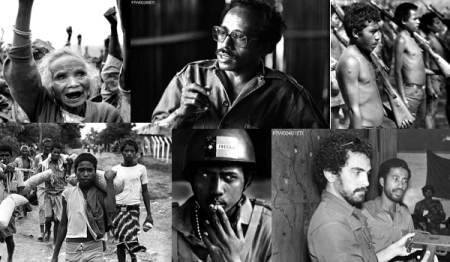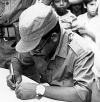A highly-principled and tenacious supporter of East Timorese self-determination and independence since 1975, former Australian Senator Gordon McIntosh sadly passed away on Sunday, 10 March 2019.
We devote this page to the memory of his unique role in the history of modern Timor-Leste – particularly during the 1974-1999 years of decolonisation, occupation and liberation.
More will be added to this page over the coming days. Links to material about Gordon McIntosh or comments about his Timor role are warmly welcomed.

Gordon McIntosh, visited by young East Timorese in Perth, January 2016
A brief Timor biography
Gordon McIntosh began his working life at aged 15 as an apprentice metal worker in the Glasgow shipyards. Migrating from Scotland with his wife Betty in 1950, he quickly found skilled metal work in Perth, Western Australia, where he was also very active in the union movement.
He began serving on the State Executive of the Australian Labor Party as early as 1952. He was elected a Labor Party Senator in the Australian Parliament in 1974 and served in that role until 1987.
Timor roles
During those years in the Senate he played a major part in keeping the Timor issue alive in the Parliament, despite the actions and policies of successive Australian Governments (Labor and Liberal) to oppose East Timorese self-determination and independence.
In addition to the many parliamentary questions asked by Senator McIntosh, he is best known as Chair of the 1982-83 Senate Inquiry about East Timor and his membership of the Australian Parliamentary Delegation to Indonesia and East Timor in 1983.
His dissent from the formal report of the Delegation was widely reported in Australia and welcomed by the Resistance in Timor. His dissent played a key part in nullifying the Hawke Labor Government’s attempts to over-ride Labor policy supporting East Timorese self-determination.
Outside parliament he addressed many public meetings in Australia, New Zealand and New York. He petitioned the United Nations Decolonisation Committee in 1982 and joined others on the Lusitania Express peace ship mission to Timor in 1992.
In 2014, Gordon McIntosh was awarded the Order of Timor-Leste for his contribution to the East Timorese struggle for independence. In 2016 he visited Timor-Leste as a guest of the State. During this visit he met for the first time the resistance veterans who had applauded his support in the 1980s.
Up until a few months before his death at age 93, Gordon McIntosh retained a vivid recall of his Timor experiences and maintained an active interest in the emerging state of Timor-Leste. With his passing, the East Timorese community and its overseas support network lost one of its staunchest friends.
Various items on Gordon McIntosh’s Timor record
Australian Parliamentary Biography
A formal biography of Gordon McIntosh’s early life and parliamentary record.
Order of Timor-Leste
Notes in support of Gordon McIntosh’s 2014 Ordem de Timor-Leste award.
McIntosh / Ulun Toos
Timor Archives backgrounder to a ‘lost’ 1988 Xanana Gusmao letter to McIntosh and McIntosh’s 2015 reply.
Gordon McIntosh Timor Archives (1)
A preliminary guide to the Timor papers of Gordon McIntosh
Gordon McIntosh Timor Archives (2)
An online selection of digital copies of McIntosh’s Timor papers.
Deceit, dissent and the verdict of history
Clinton Fernandes’ paper on the context and aims of the 1983 Parliamentary delegation to Timor and the significance of McIntosh’s dissent from the official delegation Report.
More to come…….



 Posted by timorarchives
Posted by timorarchives 





 Film Roll 1: UDT and others in East/West border area
Film Roll 1: UDT and others in East/West border area Film Roll 2: Declaration of Independence, 28 November 1975
Film Roll 2: Declaration of Independence, 28 November 1975 Film Roll 3: Scenes from Dili & Atauro, December 1975
Film Roll 3: Scenes from Dili & Atauro, December 1975

